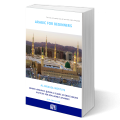Comprehensive Overview: The Evolution and History of the Arabic Language

The Arabic language, with its graceful tone, magnificent style, rich vocabulary, and historical significance, holds a unique and prominent place among the world’s languages. In this comprehensive article, we will delve deeper into the origins of Arabic, its historical development, its profound influence on other languages, and its contemporary relevance. With over 2000 years of history and more than 200 million speakers today, Arabic is a language that continues to shape cultures and societies worldwide.
The Birth of Arabic:
The roots of the Arabic language can be traced back to pre-Islamic Arabia, where various tribes spoke their distinct local Arabic dialects. During this era, poetry held immense cultural significance. Poets were revered as the custodians of tribal prestige, and their verses showcased the craft of language. In particular, Okaz, a merchant town near Mecca, stood out as a hub for poetic gatherings and celebrations, further nurturing the evolving Arabic dialects.
It was in Mecca, the center of commerce, culture, and religion, that Arabic began to emerge as a dominant dialect. However, it was the revelation of the Quran, the holy scripture of Islam, that marked a turning point in the evolution of the Arabic language. The Quran’s refined style and profound message left an indelible mark on Arab society, signifying the birth of Arabic as a world language. To this day, the language of the Quran serves as the benchmark for Arabic linguists and grammarians.
Words Borrowed from Arabic:
As Islam spread beyond the Arabian Peninsula, Arabic’s influence expanded far and wide. When Islam reached Andalusia in the eighth century, Arabic took root in Spain, leaving a lasting legacy. The Spanish language absorbed a plethora of Arabic words during the Muslim era, evident in place names like the illustrious “Alhambra,” derived from the Arabic word “al-Hamraa,” meaning “the Red.”
Beyond Spain, Arabic has also made a profound impact on European languages. English, for instance, boasts a range of words with Arabic origins, including “admiral,” “algebra,” “coffee,” and “giraffe.” This influence extends to many other languages in the Muslim world, with Persian and Urdu, Pakistan’s official language, bearing significant Arabic vocabulary and grammatical traces.
Arabic Influence on European Languages:
The influence of the Arabic language on European languages is a captivating tale of cross-cultural exchange. During the Middle Ages, when Europe was emerging from the Dark Ages, the Islamic world was a beacon of knowledge, science, and culture. Arabic texts on subjects as diverse as mathematics, astronomy, medicine, and philosophy were translated into Latin, introducing Europe to a treasure trove of knowledge.
One of the most significant figures in this exchange was the Persian scholar Al-Khwarizmi, whose works on algebra laid the foundation for modern mathematics. The term “algebra” itself is derived from the Arabic word “al-jabr,” a mathematical technique described in Al-Khwarizmi’s book.
Additionally, the Arabic numeral system, which includes the concept of zero, revolutionized mathematics in Europe. The word “zero” itself is derived from the Arabic word “sifr,” meaning “empty” or “zero.” This numeral system eventually replaced the Roman numerals used in Europe, simplifying calculations and contributing to the progress of science and commerce.
Arabic in Science and Medicine:
The Arabic language played a pivotal role in preserving and advancing scientific knowledge during the Middle Ages. Islamic scholars, writing primarily in Arabic, made significant contributions to fields such as astronomy, medicine, and optics. Their works were not only influential in the Islamic world but also made their way to Europe, where they had a profound impact on the Renaissance.
One of the most famous Arabic scholars of the time was Ibn Sina, known in the West as Avicenna. His groundbreaking work, “The Canon of Medicine,” became the standard medical textbook in Europe for centuries. Avicenna’s contributions to medicine, pharmacology, and anatomy were instrumental in the development of modern medical science.
The Spread of Arabic Influence in Europe:
Arabic influence in Europe extended beyond science and mathematics. It left a mark on European languages, cuisine, and culture. The introduction of Arabic numerals revolutionized European commerce and trade, facilitating more efficient record-keeping and accounting practices.
In addition to numbers, Arabic brought a wealth of culinary knowledge to Europe. Foods like rice, sugar, and spices, originally cultivated and traded by Arab merchants, became integral to European cuisine. The Arabic influence is evident in dishes such as “paella,” a Spanish rice dish, which derives its name from the Arabic word “baqiyah,” meaning “leftovers.”
Arabic also left an indelible mark on European architecture and design. The distinctive architectural styles found in Spain, with their intricate geometric patterns and ornate decorations, reflect the influence of Arabic design principles. The Alhambra Palace in Granada, Spain, stands as a testament to this architectural fusion, blending Islamic and European styles.
Arabic in Modern Diplomacy:
In the modern world, the Arabic language continues to play a significant role in diplomacy and international relations. It serves as a means of communication for countries in the Arab League, a regional organization that promotes economic, cultural, and political cooperation among Arab nations. Arabic’s status as an official language at the United Nations further underscores its importance in global diplomacy.
Arabic as a Living Language:
Today, Arabic is spoken by more than 200 million people in the Arab world, where it serves as an official language in 22 countries. The Arabic language’s diversity is reflected in its various dialects, each with its unique features and nuances. While Modern Standard Arabic is used in formal contexts, regional dialects are prevalent in everyday communication.
Arabic is also an important language in many countries bordering the Arab world, such as Mali, Niger, Chad, Eritrea, Djibouti, Ethiopia, and Somalia. In these regions, Arabic serves as a lingua franca, facilitating communication among diverse linguistic communities.
Arabic-speaking communities have also emerged in parts of southern Turkey and southwestern Iran, a testament to the language’s global reach. With the immigration of nationals from Arab countries to countries outside the Arab world, Arabic has spread to almost every corner of the earth.
Arabic in the Modern World:
In the contemporary world, Arabic continues to thrive and evolve. It has become a global language of commerce, with Arabic-speaking countries playing a significant role in international trade and economics. The Arabian Peninsula, with its vast reserves of oil and natural resources, has positioned itself as a key player in the global economy, further enhancing the importance of the Arabic language in business and diplomacy.
Moreover, Arabic has found a new platform in the digital age. The internet and social media have provided a global stage for the Arabic language, allowing speakers to connect, share ideas, and contribute to the digital landscape. Arabic content on platforms like YouTube, Twitter, and Instagram has garnered millions of followers, bridging cultural gaps and fostering a sense of community among Arabic speakers worldwide.
Arabic in Education:
Arabic’s significance extends to education, particularly in the Muslim world. Many non-Arab Muslim children begin their Arabic language education at an early age, driven by the desire to read and understand their religion more profoundly. The ability to read the Quran in its original language is a cherished goal for Muslims, and this motivates millions to learn Arabic.
Arabic language departments and programs have proliferated in universities around the world, catering to students interested in the language’s rich history and contemporary importance. Arabic literature, poetry, and culture have also gained recognition and appreciation in academic circles, further cementing Arabic’s place in the global curriculum.
Conclusion:
The Arabic language’s journey from its humble tribal origins to becoming a global force is a testament to its enduring significance. Its influence on world languages, cultures, and religions cannot be overstated. As we continue to witness its impact on contemporary society and its role as a bridge between diverse communities, the magnificence of the Arabic language remains undiminished. Its history, rich vocabulary, and global reach make Arabic an invaluable treasure of human communication, one that will continue to shape our world for generations to come. Arabic’s legacy is one of enduring elegance, profound influence, and timeless relevance, and its future is as bright as its illustrious past.
The Al-Dirassa Institute provides a range of online courses in Arabic, Quran, and Islam tailored for non-Arabic speakers. To enroll in our courses or learn more, please don’t hesitate to get in touch with us today.
Chosen and Trusted by Thousands of Satisfied Learners
Discover the experiences of our delighted clients who have thoroughly enjoyed utilizing this standout feature.
Alhamdulillah I‘m very pleased with the arabic and Qur’an lessons I receive from teacher Umm Tasneem and I‘m also content with the al-dirassa administration team who were very quick in answering any questions I had. In a month I progressed a lot and I cannot wait to continue my studies with al-dirassa. May Allah reward everyone at al-dirassa.
 Verified review - view original
Verified review - view original
My Qur’an teacher is fantastic, she teaches me in a loving and kind way where I look forward to the lessons and learn so much. My Arabic teacher is equally as nice and has a lot of patience with me, she has great expertise in the field and I’ve progressed really quickly with her. Thank you Al-dirassa!
 Verified review - view original
Verified review - view original
Book your free trial lesson
Don’t want to go through the translation anymore?
30 free minutes with your qualified Egyptian teacher.




